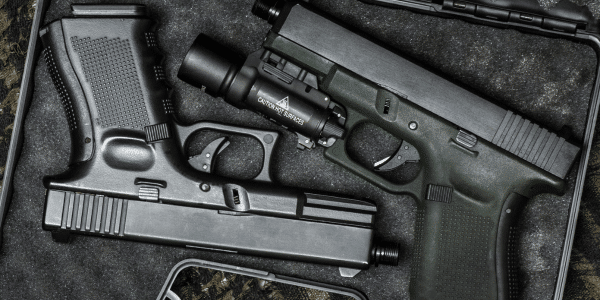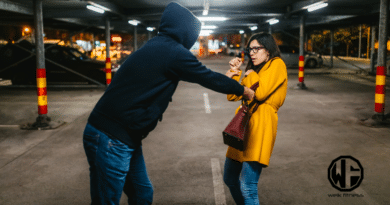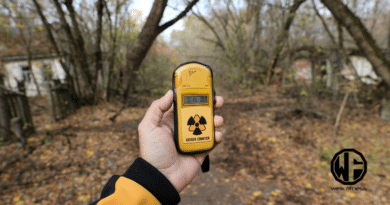Concealed vs. Open Carry: Weighing Your Self-Defense Options
The debate surrounding concealed vs. open carry stands at the intersection of individual rights, public safety, and the complex landscape of gun legislation with gun owners. Yet, when the topic arises of how to carry a handgun, someone’s butthole always seems to pucker up, and their blood pressure goes through the roof. As the steam blows out from their ears, you can sit there with your bag of popcorn and watch the debate unfold. Who’s right? Who’s wrong?
In a nation that upholds the Second Amendment as a fundamental right to carry your firearm, how individuals choose to bear arms has become a subject of fervent discussion and considerable divergence of opinion. This discourse is not merely confined to the realm of constitutional rights but extends to broader questions about the implications for public perception, law enforcement practices, and societal attitudes toward firearms.
Understanding the dynamics and consequences of concealed vs. open carry becomes paramount as citizens navigate the nuances of gun ownership.
This article seeks to unravel the layers of this multifaceted debate, examining the advantages and drawbacks of each approach, delving into the legal frameworks that govern them, and exploring the social, cultural, and law enforcement implications accompanying these choices.
Whether viewed through the lens of personal freedom or communal safety, the concealed vs. open carry dialogue reflects the ongoing evolution of societal norms and the intricate interplay between individual liberties and the collective well-being of the community.
Let’s go on a little journey as we navigate this complex terrain, seeking to shed light on the intricacies of a conversation that continues to shape the contours of American discourse on gun rights as it relates to open carry and concealed carry.
Disclaimer: This article is for informational purposes only. I am not a criminal defense attorney, I have not studied case law or criminal law, and I am not giving you legal advice in this article. Know the laws where you live regarding concealed vs. open carry.
Table of contents
- Why Are There Such Strong Feelings Towards Concealed vs. Open Carry?
- 1. Individual Rights and Freedoms to Carry a Gun
- 2. Perceptions of Safety with a Firearm
- 3. Cultural and Regional Variances
- 4. Fear and Comfort Levels
- 5. Public Perception and Media Influence
- 6. Law Enforcement Considerations
- 7. Community and Social Dynamics
- 8. Political and Legislative Context
- 9. Perceived Threats to Public Safety
- 10. Historical Context and Traditions
- Understanding Concealed Carry
- Understanding Open Carry
- Concealed Carry vs. Open Carry Across States: Know Your Options
- Legal Framework
- Public Perception and Social Impact of Open Carry vs Concealed Carry
- Navigating the Complexities of Concealed and Open Carry
- Open Carry vs. Concealed Carry FAQs
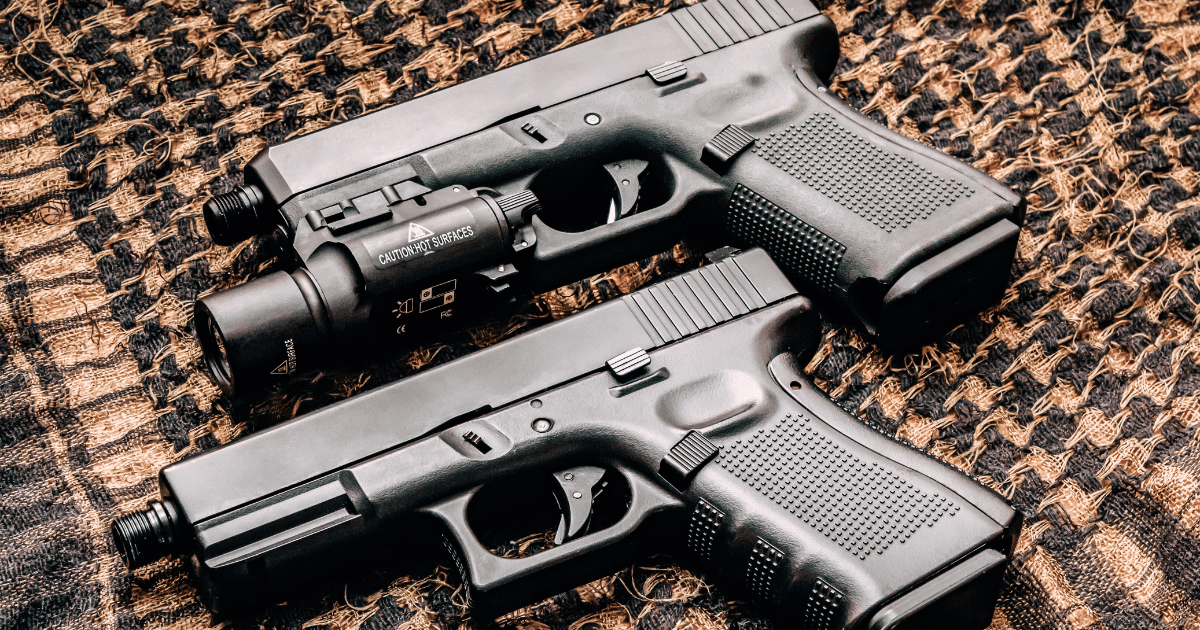
Why Are There Such Strong Feelings Towards Concealed vs. Open Carry?
The debate between concealed vs. and open carry elicits strong feelings due to a complex interplay of factors, encompassing individual rights, public safety concerns, cultural attitudes, and historical context. The decision to carry a firearm is extremely personal. If you carry a firearm (either open or concealed) without proper training, you can do yourself and others great bodily harm and even death. Owning a gun comes with much responsibility.
Here are several reasons and differences between open and concealed carry and why people hold such strong opinions on the topic of open carry or concealed:
1. Individual Rights and Freedoms to Carry a Gun
Advocates for both concealed and open carry often frame their arguments within the context of individual rights and freedoms. Those in favor of concealed carry may emphasize the right to privacy and personal security, while supporters of open carry might stress the importance of exercising Second Amendment rights openly. Your method of carry depends on your individual viewpoints and whether you are opposed to open carry or concealed carry. Your means of carry is completely up to you and the laws governing the areas.
2. Perceptions of Safety with a Firearm
Strong feelings on this issue are often rooted in differing perceptions of safety. Supporters of concealed carry may argue that discreetly carrying a firearm enhances personal safety, while proponents of open carry might contend that the visible presence of firearms acts as a deterrent, contributing to a safer environment.

3. Cultural and Regional Variances
Attitudes towards open or concealed carry can be deeply influenced by cultural norms and regional differences. In areas where gun ownership is culturally ingrained, open carry might be viewed as a symbol of freedom and self-reliance, whereas in regions with a different cultural history, it could be perceived as threatening.
4. Fear and Comfort Levels
The sight of a visible firearm can evoke a range of emotions, from reassurance to discomfort or fear. Individuals’ comfort levels with the presence of firearms in public spaces contribute to the intensity of their opinions on whether these weapons should be concealed or openly carried.
5. Public Perception and Media Influence
Media portrayal and public perception of concealed and open carry practices also play a role. High-profile incidents and media coverage can shape how people view these practices, influencing their attitudes and opinions.
6. Law Enforcement Considerations
Law enforcement perspectives further contribute to the debate. Some officers may feel more comfortable when civilians carry discreetly, while others may find comfort in the visible presence of firearms. Law enforcement experiences and opinions can vary, influencing public discourse on the issue.
7. Community and Social Dynamics
The debate is also influenced by broader community and social dynamics. Communities with a strong gun culture may embrace open carry as a norm, while others may prefer the discreetness associated with concealed carry.
8. Political and Legislative Context
The political and legislative landscape adds another layer to the debate. Changes in gun laws, court decisions, and political rhetoric can trigger emotional responses and shape public opinion on the acceptability of concealed and open carry.
9. Perceived Threats to Public Safety
Concerns about public safety and the potential misuse of firearms drive passionate arguments on both sides. Advocates for concealed carry often stress the importance of responsible gun ownership, while opponents may fear the increased visibility of firearms in open carry scenarios.
10. Historical Context and Traditions
Historical events and traditions related to gun ownership contribute to the strength of opinions. Regions with a deep-rooted history of gun ownership may approach the issue differently than areas with less historical attachment to firearms.
Understanding Concealed Carry
In the realm of self-defense and personal protection, the choice of concealed vs. open carry stands as a pivotal decision, shaped by legal considerations, tactical advantages, and the intricacies of accessibility. For many who carry a firearm in a concealed manner, they would need to have a license to carry (carry license or permit) according to their state laws.
Concealed carry, the discreet practice of having a concealed firearm in public spaces, raises pertinent questions about the balance between individual rights and community safety. If you’re a concealed carrier, no part of the firearm or concealed holster should be visible. You should also consider the type of concealed carry holsters you use in the carry of firearms. For most people, concealed carry makes sense since the act of concealed carry involves carrying a firearm on you without being visible to others.
Related Article: Stylish and Safe — Creating the Perfect Concealed Carry Outfit
This section aims to illuminate the nuances of concealed carry, starting with a definition and an exploration of the legal landscape. We will then delve into the advantages it offers, such as the enhanced element of surprise and potential reduction in public intimidation.
However, we’ll also scrutinize the challenges associated with accessibility, recognizing that the effectiveness of concealed carry hinges not only on discretion but also on the ability to swiftly and safely respond to potential threats.
Personally, I continue to carry concealed every day. I love my Frankenstein P365X. While there are arguments for open carry, like being able to carry a larger firearm, I like the fact that the state of Pennsylvania allow concealed carry permits to be registered for those who want to use it in self-defense. Some states won’t allow you to get a permit for that reason, which blows my mind. Concealed carry requires you to dress more around your gun, but concealed carry is also a way to conspicuously go through your day without everyone looking at you weirdly for carrying a gun.
Definition and Legal Aspects of Concealed Carry
Concealed carry refers to the practice of carrying a concealed firearm in public, typically on one’s person or in close proximity, without the firearm being visible to others. The legal landscape surrounding concealed carry varies significantly across jurisdictions, with states adopting different approaches to licensing, permitting, and regulations.
Related Article: Concealed Carry Comfort — How to Select the Best Gun Belt
Understanding these legal intricacies and state and federal laws is crucial for individuals considering concealed carry as an option for personal protection.
Advantages and Disadvantages of Concealed Carry
1. Enhanced Element of Surprise
Concealed carry offers the advantage of surprise and quick access to your gun, providing individuals with the element of unpredictability in potential self-defense situations against a bad guy. This surprise factor can be a significant tactical advantage, catching potential threats off guard and allowing the concealed carrier to respond effectively.
2. Potential for Reduced Intimidation
One of the perceived advantages of concealed carry is the potential to reduce intimidation in public spaces. Unlike open carry, which can elicit discomfort or concern from those who may not be accustomed to seeing firearms, a concealed weapon is out of sight, mitigating the unease that visible firearms may cause.
3. Challenges Related to Accessibility
While concealment provides a level of discretion, it also presents challenges related to accessibility. Gun owners need to be able to grab their firearm quickly in life-or-death scenarios. In high-stress situations, quickly and safely accessing a concealed firearm can be demanding. Individuals opting for concealed carry must invest in appropriate holsters, clothing choices, and training to address these challenges and ensure that their concealed firearm remains a practical and effective means of self-defense.
Where Can You NEVER Conceal Carry?
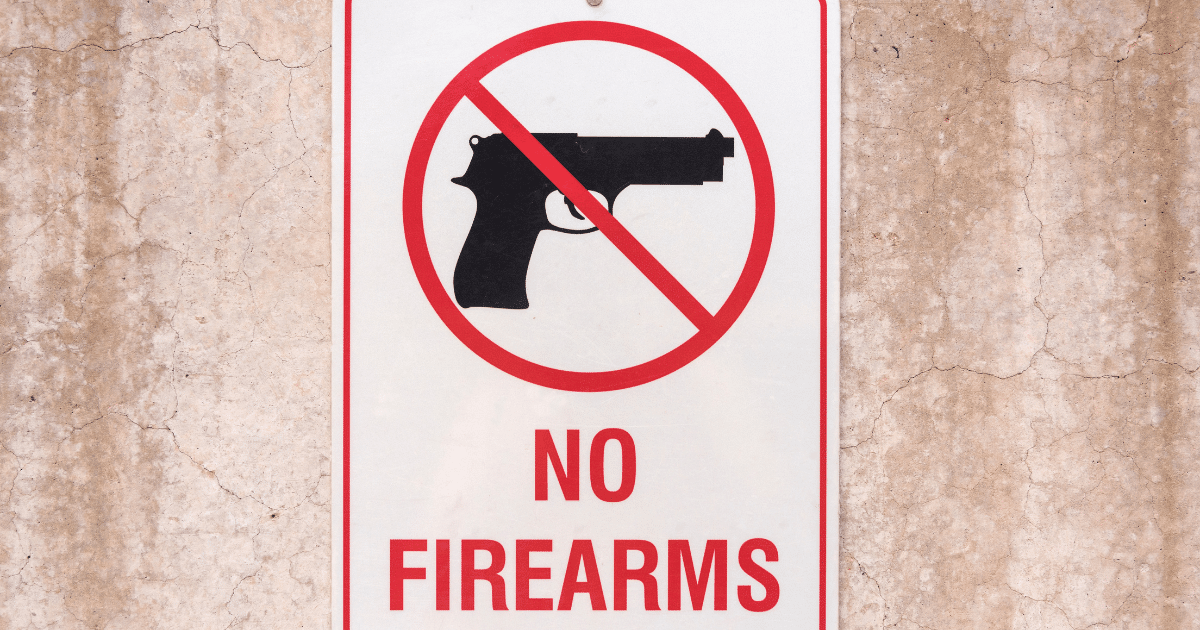
While concealed carry laws vary across jurisdictions, there are generally common restrictions on carrying concealed weapons in certain places. Individuals need to be aware of these restrictions to avoid legal consequences. That being said, I’m a huge advocate that we should rethink gun-free zones for schools and businesses.
Here are common places where you typically cannot conceal carry:
1. Federal Facilities
Concealed carry is generally prohibited in federal facilities such as courthouses, post offices, and government buildings according to federal laws. These areas often have strict security measures, and carrying a concealed weapon is strictly regulated.
2. Schools and Universities
Most states prohibit concealed carry in K-12 schools and on university campuses. This restriction is in place to ensure the safety of students and staff.
3. Airports and Aircraft
Concealed carry is typically not allowed in secure areas of airports or on commercial aircraft. Federal regulations and airline policies strictly control the possession of firearms in these environments.
4. Public Buildings with Security Measures
Certain public buildings, like museums, libraries, or concert halls, may prohibit concealed carry, especially if they have security measures in place. Check for posted signs indicating firearm restrictions.
5. Private Property with No Weapons Policies
Private property owners have the right to set rules regarding firearms on their premises. If a business or establishment has a “No Weapons” policy, concealed carry may be prohibited.
6. Establishments Serving Alcohol
In many jurisdictions, carrying a concealed weapon is prohibited in places that primarily serve alcohol. This includes bars and some restaurants where the primary source of revenue is derived from alcohol sales.
7. State and National Parks
While regulations can vary, some state and national parks may have restrictions on concealed carry, particularly in visitor centers or other designated areas.
8. Sports Arenas and Stadiums
Events at sports arenas and stadiums often have restrictions on concealed carry. Check the policies of the venue before attending.
9. Polling Places
Carrying a concealed weapon may be restricted in polling places during elections. The aim is to maintain a secure and non-threatening environment for voters.
10. Secure Areas of Law Enforcement Facilities
Concealed carry is typically prohibited in secure areas of law enforcement facilities, including police stations and detention centers.
Understanding Open Carry
In the landscape of firearm possession, open carry (sometimes referred to as constitutional carry or permitless carry) stands as a visible expression of an individual’s right to bear arms. A practice where you openly carry a firearm in public spaces, open carry is legal in many states and presents a distinct set of considerations and challenges that intersect with legal frameworks, public perceptions, and law enforcement dynamics.
This section aims to unravel the layers of open carry, beginning with its definition and legal intricacies. We will then explore the perceived advantages, such as the potential deterrent effect on criminal activity while acknowledging the increased visibility and the potential for intimidation that can accompany this approach.
Related Article: Situational Awareness — Defense Through Environmental Perception
Additionally, we will delve into the nuanced interplay between public perception and the considerations faced by law enforcement when addressing openly carried firearms. Join us as we navigate the complexities of open carry, seeking to understand its role in the broader discourse surrounding individual rights and community safety.
Definition and Legal Aspects
Open carry refers to and represents a distinct approach to firearm possession, where individuals visibly carry firearms in public spaces, often holstered and in plain view. The legal landscape surrounding open carry is diverse, with states adopting different regulations governing when and where individuals can openly carry firearms.
As we unravel the intricacies of open carry, it is imperative to grasp both its legal foundations and the broader implications for individuals and communities. If you’re carrying your gun openly, knowing your state laws is essential.
Advantages and Disadvantages
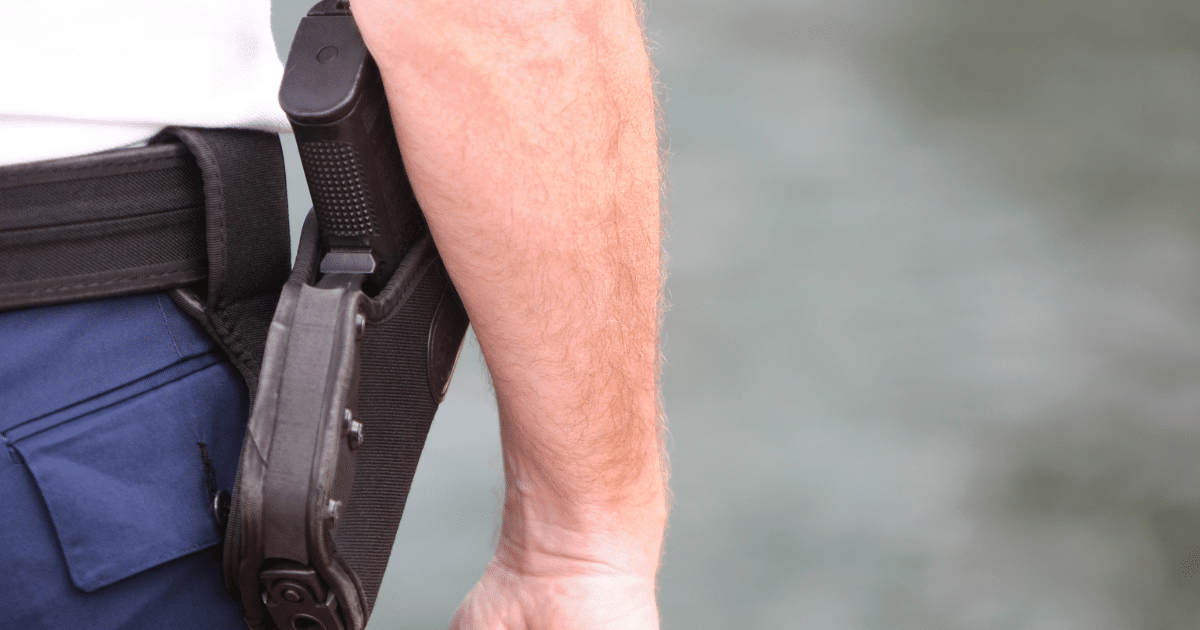
1. Deterrent Effect
Advocates of open carry often highlight its potential deterrent effect on criminal activity. The visible presence of a firearm in an open carry holster is believed by some to discourage unlawful behavior, acting as a preventative measure in public spaces. However, the effectiveness of this deterrent effect is subject to debate and can vary based on factors such as local culture and societal norms.
2. Ability to Draw
Open carry also gives you a faster draw since you don’t need to break through any garments on your way to your firearm. Open carry provides the quickest access to your firearm, which is one of the cons of concealed carry. That said, carry guns that are openly holstered remove your element of surprise, but if comfort is what you’re after, open carry offers a much nicer experience in the comfort department.
3. Increased Visibility and Potential for Intimidation
While open carry may serve as a deterrent, it also introduces a heightened visibility of firearms, potentially causing unease among those not accustomed to seeing weapons in public. The increased visibility can inadvertently lead to perceptions of intimidation, prompting concerns about public safety and the impact on community dynamics.
4. Public Perception and Law Enforcement Considerations
The public’s perception of open carry is a crucial aspect of the debate. Individuals openly carrying firearms may be viewed with a spectrum of emotions—from reassurance to discomfort—depending on the cultural context. Law enforcement, too, must navigate the complexities of addressing open carry, balancing public safety concerns with the rights of individuals to bear arms openly.
Where Can You NEVER Open Carry?
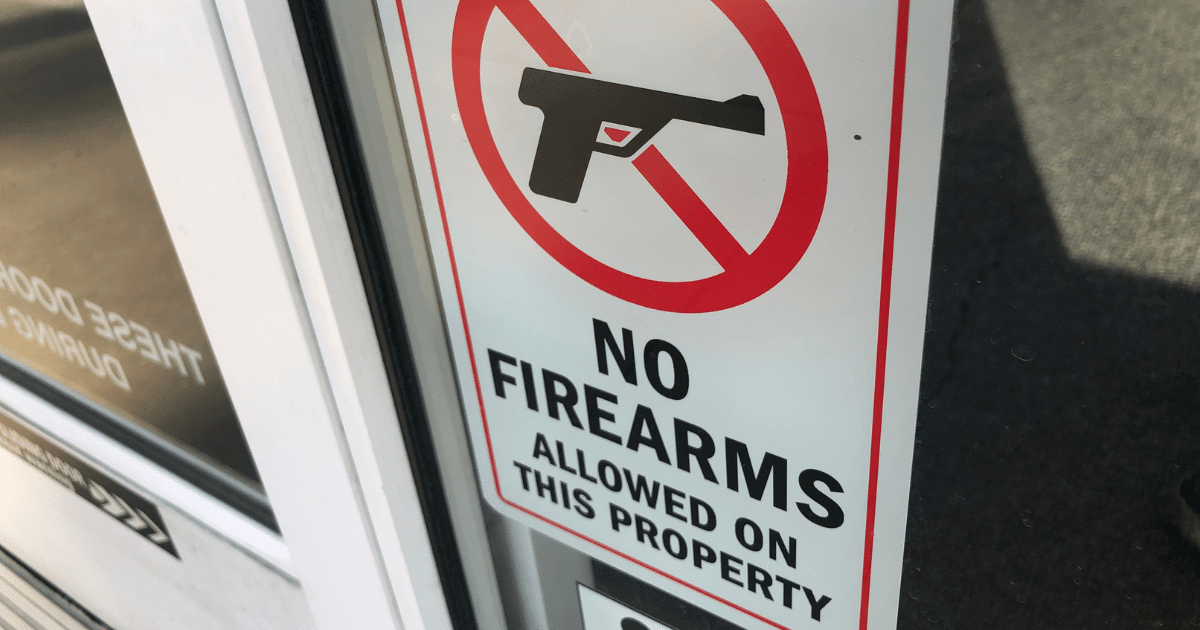
While there are some states where you can open carry a firearm without needing a permit or where states do not require open carriers to have a license to legally carry. That said, you need to understand the laws regarding open carry and that open carry can also lead you to legal issues if your temper gets flared.
Related Article: Unconstitutional Concealed Carry Reciprocity & CCW Gun Laws
Open carry laws and restrictions vary by state, and there isn’t a universal answer to where you can never open carry. However, some common restrictions exist across many jurisdictions. It’s essential for individuals to be aware of these restrictions to comply with the law and avoid legal consequences. Here are general places where open carry is often restricted:
1. Federal Facilities
Open carry is typically prohibited in federal facilities such as courthouses, post offices, and government buildings. These locations usually have strict security measures and firearm restrictions.
2. Schools and Universities
Many states prohibit open carry in K-12 schools and on university campuses. These restrictions are in place to ensure the safety of students and staff.
3. Secure Areas of Airports
Open carry is generally not allowed in secure areas of airports. Federal regulations and airport policies strictly control the possession of firearms in these environments.
4. Public Buildings with Security Measures
Open carry may be restricted in public buildings with security measures, such as metal detectors or security checkpoints. Signs indicating firearm restrictions are often posted in these locations.
5. Private Property with No Weapons Policies
Private property owners have the right to set rules regarding firearms on their premises. If a business or establishment has a “No Weapons” policy, open carry may be prohibited.
6. Establishments Serving Alcohol
Many jurisdictions restrict open carry in places that primarily serve alcohol, including bars and some restaurants. Laws vary, so it’s crucial to check local regulations.
7. Sports Arenas and Stadiums
Events at sports arenas and stadiums often have restrictions on open carry. Check the policies of the venue before attending.
8. Polling Places
Open carry may be restricted in polling places during elections to maintain a secure and non-threatening environment for voters.
9. Secure Areas of Law Enforcement Facilities
Open carry is typically prohibited in secure areas of law enforcement facilities, including police stations and detention centers.
10. Prisons and Correctional Facilities
Open carry is generally prohibited in and around prisons and correctional facilities.
Concealed Carry vs. Open Carry Across States: Know Your Options
Navigating the landscape of concealed vs. open carry is a nuanced journey shaped by the diverse laws that exist across states. In the United States, the ability to exercise the right to bear arms can vary significantly depending on your geographical location.
This section sheds light on the disparities in concealed vs. open carry laws, emphasizing the importance of understanding your options based on where you reside.
Concealed Carry Laws Across States
1. Shall-Issue States
In some states, obtaining a concealed carry permit follows a “shall-issue” policy, where permits are generally granted unless specific disqualifying factors exist. Understanding the criteria for eligibility and the application process in these states is crucial for those considering concealed carry as an option.
2. May-Issue States
Conversely, “may-issue” states grant officials discretion in issuing concealed carry permits. Individuals in these states may face a more subjective evaluation of their application, with authorities having the authority to determine whether the applicant has a justifiable need for concealed carry.
Open Carry Laws Across States
1. Permissive Open Carry States
Some states allow open carry without the need for a permit, permitting individuals to visibly carry firearms in public spaces. It’s essential to be aware of the specific locations and situations where open carry is permissible, as this can vary among states with permissive open carry laws.
2. Restrictive Open Carry States
Other states may have restrictions or outright prohibitions on open carry, necessitating a more cautious approach. Understanding the limitations and potential legal consequences of openly carrying firearms in these states is paramount for responsible firearm owners.
Researching Your State’s Laws
1. Online Resources
Utilize reputable online resources to access up-to-date information on concealed and open carry laws in your state.
2. Legal Consultation
Seek legal consultation or guidance if needed, ensuring a thorough understanding of the specific regulations that apply to your location.
As a responsible firearm owner, staying informed about the concealed vs. open carry laws in your state is not only a legal obligation but also an essential step toward making informed decisions about your personal safety.
By understanding the nuances of these laws, you empower yourself to navigate the complex landscape of firearm possession within the legal parameters of your specific jurisdiction.
Legal Framework
In the realm of firearm regulation, the legal landscape governing concealed vs. open carry is far from uniform, presenting a tapestry of variations that reflect the diverse attitudes and priorities of each state.
This section takes us on a journey through the intricacies of these regulations, shedding light on the nuanced differences that shape how individuals can lawfully carry firearms. From the eligibility criteria for concealed carry permits to the permissibility of openly carrying firearms without a permit, the legal frameworks are as diverse as the states themselves.
Variations in Concealed Carry Laws
The legal landscape surrounding concealed carry is a patchwork of regulations, with significant variations from state to state. States exercise their autonomy in determining eligibility criteria, application processes, and restrictions on concealed carry permits.
Related Article: How To Get a PA Concealed Carry Permit
Understanding these variations is essential for individuals navigating the complexities of concealed carry across state lines. From “shall-issue” states, where permits are generally granted unless there is a disqualifying factor, to “may-issue” states, where officials have discretion in issuing permits, the legal nuances profoundly influence how citizens exercise their right to concealed carry.
Variations in Open Carry Laws
Similar to concealed carry, open carry laws exhibit a wide range of differences across states. While some states allow open carry without the need for a permit, others may impose restrictions or even outright prohibitions.
The legal permissibility of openly carrying firearms in specific locations, such as schools or government buildings, further adds to the complexity. Understanding the specific regulations of each jurisdiction is crucial for individuals choosing to exercise their right to open carry responsibly.
Public Perception and Social Impact of Open Carry vs Concealed Carry
In the debate over concealed vs. open carry, the lens through which the public perceives these methods of firearm possession plays a pivotal role in shaping the broader narrative.
This section looks at the intricate dynamics of public perception and the social impact that concealed and open carry practices have on communities. We will explore how each method is perceived by the public, recognizing the potential for varied reactions and attitudes that influence the societal acceptance of firearms.
Related Article: Appendix Carry — Why It’s the Best Concealed Carry Position
The impact on public safety perceptions will also be scrutinized, considering contrasting perspectives on how concealed and open carry contribute to or detract from overall community safety.
Additionally, we will navigate the complex terrain of cultural perspectives, acknowledging that the acceptance or apprehension toward firearm visibility is deeply rooted in diverse cultural norms and historical contexts.
How is Concealed Carry vs. Open Carry Perceived by the Public?
The public’s perception of concealed vs. open carry plays a pivotal role in shaping the discourse around firearm possession.
Concealed carry, by its very nature, aims to keep firearms out of plain view, potentially fostering a sense of normalcy in public spaces.
On the other hand, open carry, with its visible display of firearms, may evoke varied reactions, ranging from reassurance among proponents to discomfort or concern among those unaccustomed to such displays.
Exploring these perceptions provides insights into the societal attitudes and expectations surrounding the presence of firearms in everyday life.
The Impact on Public Safety Perceptions of Concealed vs. Open Carry
The perceived impact on public safety is a critical facet of the concealed vs. open carry debate. Advocates of concealed carry often argue that the discreet nature of carrying a concealed firearm enhances public safety by avoiding unnecessary alarm.
In contrast, proponents of open carry may contend that the visible presence of firearms acts as a deterrent, contributing to an overall safer environment. Evaluating these contrasting perspectives is essential for understanding how the choices individuals make regarding firearm visibility intersect with broader perceptions of safety within communities.
Consideration of Different Cultural Perspectives on Concealed Carry vs. Open Carry
The acceptance or apprehension toward concealed vs. open carry is not universal, and cultural perspectives play a significant role in shaping these attitudes.
Cultural norms, historical contexts, and regional traditions contribute to diverse viewpoints on the presence of firearms in public spaces. Recognizing and understanding these cultural nuances is essential for fostering a more comprehensive and nuanced dialogue on firearm possession, one that respects the diversity of perspectives that exist within the broader societal framework.
As we dig into the realm of public perception and social impact, we aim to unravel the complex interplay between individual choices, societal expectations, and the broader implications for community well-being. Join us as we navigate the intricate tapestry of public attitudes toward concealed and open carry, exploring the multifaceted dimensions contributing to the ongoing discourse on gun rights and public safety.
Navigating the Complexities of Concealed and Open Carry
In the discourse surrounding concealed vs. open carry, a nuanced tapestry of legal, social, and cultural considerations unfolds.
As we traverse the intricacies of this debate, it becomes evident that the choices individuals make regarding firearm possession are deeply entwined with the diverse legal frameworks that govern our nation.
Whether it’s the enhanced element of surprise in concealed carry or the potential deterrent effect of open carry, each method carries its own set of advantages and challenges. The mosaic of public perception, shaped by attitudes towards visibility and cultural nuances, further adds complexity to this multifaceted dialogue.
Understanding the variations in concealed vs. open carry laws across states proves essential for responsible firearm ownership, emphasizing the importance of staying informed about local regulations.
As we conclude this exploration, it is clear that the choices we make regarding concealed vs. open carry are not just matters of personal preference but are integral to the larger conversation about individual rights, community safety, and the intricate fabric of our society.
As a side note to close out this article, if you want to support our website and are in need of any tactical gear (or any product for that matter), anything you purchase using our links below will provide us with a small commission. We don’t charge for our free content and our goal is to keep it that way. We don’t have a Patreon account to put things behind a paywall, nor do we sell pics of our feet on OnlyFans.
If you choose to use the links below and make a purchase (at no additional cost to you), we greatly appreciate your support as it helps us continue to publish free content (like this article) on our website:
- Optics Planet (use code SAS5 at checkout for 5% off)
- Amazon
We have also partnered with CCW Safe. It’s the concealed carry coverage that I personally have for myself and my family in the event we need to defend our lives. Feel free to use our CCW Safe link to sign up and get some coverage to protect yourself and your family.
Also if you have a product you would like us to check out and potentially review, please contact us and let’s discuss.
Open Carry vs. Concealed Carry FAQs
No, the legality of concealed carry varies by state. It’s crucial to be aware of and comply with the concealed carry laws in the specific state where you reside or plan to carry.
No, open carry laws also vary by state. While some states allow open carry without a permit, others have restrictions or prohibitions. It’s important to research and understand the laws in your jurisdiction because some states frown upon open carry as well as concealed.
Certain places, such as federal facilities, schools, and airports, typically prohibit concealed carry. Additionally, private property owners may set rules, and “No Weapons” policies in businesses should be respected.
Similar to concealed carry, there are restrictions on open carry in federal facilities, schools, airports, and private property with specific policies. Research and understanding local regulations are crucial.
In places with security measures, both open and concealed carry may be restricted. Signs indicating firearm restrictions are often posted in such locations. Being that open carry is the practice of wearing a visible gun on you, anywhere you go (that has security) will be watching you more closely, even if they allow open carry on their premises.
Laws regarding open carry in places serving alcohol vary. Some jurisdictions restrict open carry in bars and restaurants, while others may allow it. Check local regulations to ensure compliance.
Reputable online resources, including state government websites and legal databases, provide up-to-date information on concealed and open carry laws. Consulting with local law enforcement or legal professionals can also offer guidance.
Yes, cultural perspectives on firearm visibility vary. Understanding and respecting these cultural nuances is important to navigate the social impact of both concealed and open carry practices.
Regulations on carrying firearms in national parks can vary. Check the specific rules of the national park you plan to visit to ensure compliance with applicable laws.
If you have specific questions or concerns, consider reaching out to local law enforcement agencies or consulting with legal professionals who specialize in firearm laws to ensure accurate and up-to-date information.


*Disclosure: This article may contain affiliate links or ads, which means we earn a small commission at no extra cost to you if you make a purchase through these links. These commissions help support the operation and maintenance of our website, allowing us to continue producing free valuable content. Your support is genuinely appreciated, whether you choose to use our links or not. Thank you for being a part of our community and enjoying our content.
PLEASE CONSIDER SHARING THIS ON YOUR SOCIAL MEDIA TO HELP OTHERS LEARN MORE ABOUT THIS TOPIC.


